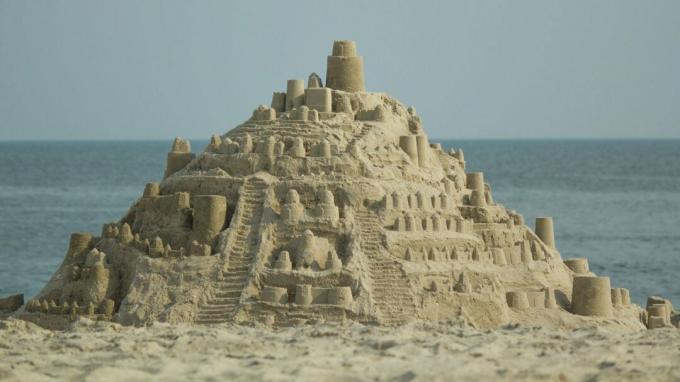Ephemeral Art: what and what are its characteristics?
Currently, it seems that we live immersed in a frenetic wave of ephemeral art, that is, non-permanent art that is created without the intention of lasting over time. Creations that use the human body as a support are ephemeral art: makeup, body painting, hairdressing and tattooing, among others; but so are manifestations such as gastronomy, fireworks or the so-called life art, for example.
What is ephemeral art and what are its characteristics? What conditions must a work have to be considered ephemeral? Is it true that ephemeral art is an exclusive manifestation of modernity??? In today's article we will try to answer these and other questions. Join us.
- We recommend you read: "The Dreamtime in Australian mythology: what is it and what impact did it have?"
What is ephemeral art?
The word ephemeral comes from the Greek ephêmeros and would come to mean "that lasts one day". Therefore, ephemeral art is any creation that meets this basic premise: transience in time. In other words, ephemeral artistic expressions do not have any intention of continuity and, since they are created, both their authors and the public know that they have an expiration date. Of course, they don't have to last a day, as the Greeks said. It can be a week, or a month, or a year. But they end up being dismantled or deleted, inevitably.
Their very temporality means, then, that they disappear quickly and that we preserve few vestiges of them. Today it is easier to immortalize this type of art, since, through video and photography, we can capture forever that creation destined to disappear.
This is what happens with body decoration work or sound and light shows, for example.. However, what happened when there was nothing to perpetuate the work? Well, simply and simply, it was lost, although there were always artists who offered to make engravings or drawings of the work in question to preserve it from time and oblivion.
This can lead us to the following question: is ephemeral art something exclusive to the 20th and 21st centuries? The answer seems to be obvious: of course not. And not only because makeup, hairstyles, and other artistic manifestations of the body have existed since the human being was on the earth, but also because ephemeral works of art have been created since ancient times in other areas that we may not even imagine, such as the architecture. But, let us start at the beginning.
commemorate the power
Ephemeral art, especially architecture, has always been linked to celebrations, both religious and civil. Even in a civilization as "stony" and monumental as ancient Egypt, reviews have been found for ephemeral monuments, built on the occasion of a festival related to the pharaoh or the gods. Also in Roman times we can find ephemeral art, especially linked to military parades.
Fashion was booming during all the centuries of the Middle Ages, but the peak came in the Renaissance and, fundamentally, in the Baroque. Special mention is given to the magnificent triumphal arches, built with ephemeral materials to celebrate the arrival in the city of a king or an important figure. During the Renaissance and Baroque periods, triumphal arches in imitation of Roman honorary structures became incredibly fashionable.
Thus, we have the arch of the Porte de Saint-Denis, built on the occasion of the entry of Henry II to Paris, in 1549; and, in a more recent period, we find the (no less than) thirteen triumphal arches of Felipe III for his arrival in Lisbon, in 1619, paid for by the guilds of the city.

commemorate death
Another architecture that gained special relevance in the Baroque (because of its special relationship with the Memento Mori so characteristic of the time) is the catafalque or burial mound, a structure made with ephemeral materials that celebrated the obsequies of an important person, generally linked to royalty. The catafalques did not always contain the coffin of the deceased, as they were often erected in the churches of the main towns in commemoration of the character's transfer.
Like all ephemeral constructions, they were made with cheap and perishable materials, such as paper, wood, cardboard or cloth.. In general, and once the obsequies had elapsed, the catafalque was dismantled and its materials were used, so it is strange that any are preserved. There are, however, notable exceptions, such as the catafalque preserved in the parish church of Arbulo, in Álava (Spain), although in this case it is an example from the 19th century.
Symbol of science and progress
Already in the 19th century we find one of the most famous manifestations of ephemeral art: the universal exhibitions, fairs where the technological and cultural advances of the different countries. The first universal exhibition was held in London in 1851 (initiated, by the way, by Alberto, Prince consort), which was a resounding success and donated to posterity the famous Crystal Palace, sadly destroyed in a fire in 1937.
In the universal exhibitions, each country was awarded a piece of land, in which they raised a pavilion of ephemeral architecture to locate their sample.. As the works were supposed to last the duration of the exhibition, at the end of the exhibition they were dismantled and their materials were used.
There are extraordinary cases of conservation of these ephemeral constructions, such as the case of the aforementioned Crystal Palace in London (which survived until the fire, almost one hundred years), or that of the very famous Eiffel Tower, destined for the Universal Exhibition in Paris in 1889 and which is currently an indisputable symbol not only of the city, but of the whole France. By the way, and as stated by Miguel Ángel Cajigal (1981) in his book Otra historia de la arquitectura (see bibliography), what we call Eiffel was actually devised by two of Gustave's employees, Nouguier and Koechlin, and "extended" by Sauvestre.
Ephemeral art today
Of course, ephemeral architecture continues to exist today. We constantly see it in festivals, celebrations and various parties, following the trail that our ancestors had already started. Curious is the case of ice art or architecture, which is gaining particular popularity lately and whose most paradigmatic example can be found in the Ice Hotel in Jukkasjärvi, Sweden.
But, above all, what is gaining real popularity are other ephemeral manifestations such as shows made with fire, light, sound and water, or life art performances.. The life art or action art (action art), which sinks its roots in manifestations such as Dadaism, bets on the constant intervention of the spectator. Thus, we find the happening (in which the viewer becomes an active subject of the performance) or installationism, which has a specific duration and allows the viewer's intervention.
Also quite common in our time is land art, an artistic expression that uses nature as a support, or urban art, personified especially in graffiti. Although more and more spaces are currently being set up for this type of art (spaces that intend to remain in the urban space), the graffiti in ephemeral art, since, initially, it is carried out on places not intended for that purpose and, as such, the graffiti are later deleted.

